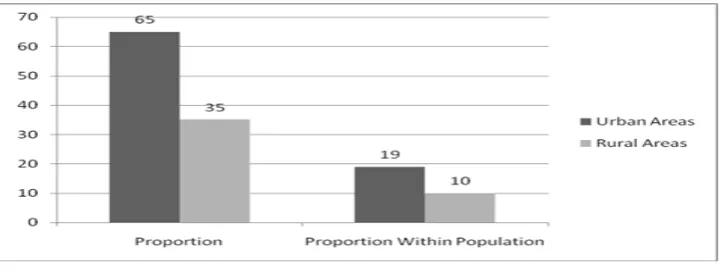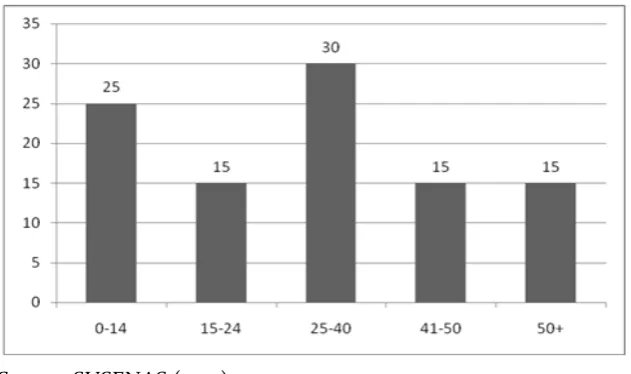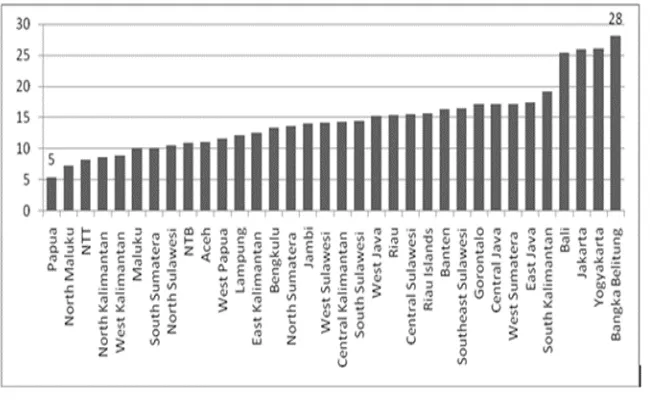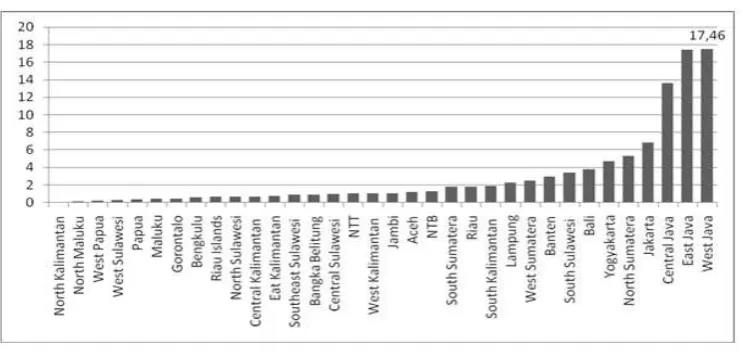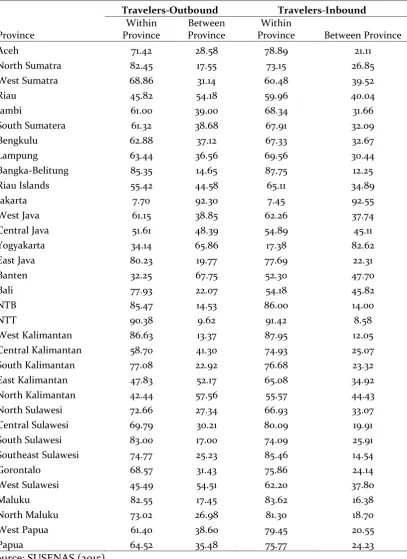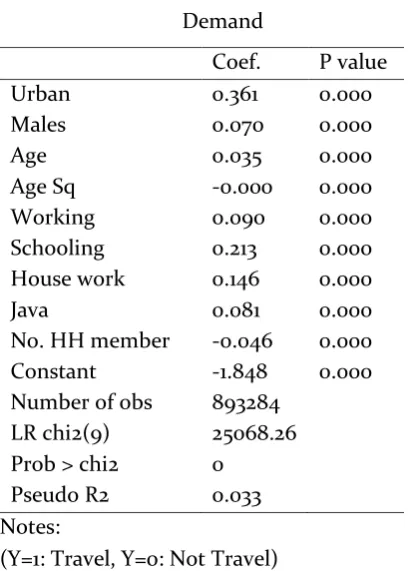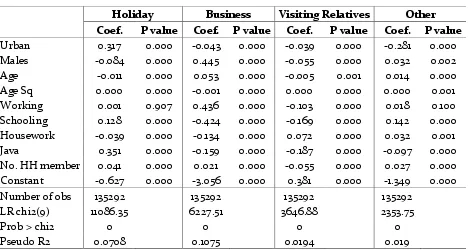Journal of Economics and Policy http://journal.unnes.ac.id/nju/index.php/jejak
The Analysis of Domestic Travelers in Indonesia
Devanto Shasta Pratomo1
Economics and Business Faculty, Brawijaya University
Permalink/DOI: http://dx.doi.org/10.15294/jejak.v10i2.11296
Received: December 2016; Accepted: February 2017; Published: September 2017
Abstract
Indonesia is the largest archipelago country in the world, making one of popular tourist destinations in Southeast Asia region for both international and domestic holidays. The main objective of the study is to examine a wide range characteristics, including demographic, employment, and spatial characteristics for domestic travel in Indonesia.The method used in the study is descriptive analysis using the 2015 National Socio-Economic Survey (SUSENAS), which is used to explain some specific characteristics of domestic travelers in Indonesia. Some regression analysis using binary probit is also added to examine the determinants of domestic travel demand in Indonesia, measured by the probability to travel within the country. The result shows that, in general, domestic travelers in Indonesia are dominated by people who are living in urban areas, people who are aged 25-40 years old, highly educated, working as paid employees, and mostly originate from provinces in Java island.For specific purposes, people who are living in urban areas are more likely travel for holidays. Males are more likely travel for business compared to females. People who do have a job are more likely travel for business purposes, while people who are at school ages are the market for holiday travel.
Key words :Travelers, SUSENAS, Indonesia, Spatial, Tourism.
How to Cite: Pratomo, D. (2017). The Analysis of Domestic Travelers in Indonesia. JEJAK: Jurnal Ekonomi Dan
Kebijakan, 10(2), 317-329. doi:http://dx.doi.org/10.15294/jejak.v10i2.11296
© 2017 Semarang State University. All rights reserved
Corresponding author :
Address: Jl. MT. Haryono 165 Malang, Jawa Timur 65145
E-mail: devanto@ub.ac.id
INTRODUCTION
Indonesia is the largest archipelago country in the world, comprising of more than 17,000 islands with abundant of culture and natural resources. Supported by the popularity of Bali as one of the main tourist destination in the world, it also makes Indonesia in general as one of the popular tourist destinations. Tourism is one sector of the Indonesia economy that contributed greatly to the economic development of country (Santi et al, 2014). Based on the data from Indonesian Central Statistical Board (BPS), tourism in Indonesia has grown moderately since the early 2000s. The number of foreign visitors visiting Indonesia increased from 5 million in 2000 to over 9 million in 2015. Tourism is also an important agent to increase economic earning, especially among developing countries (Nurbaeti et al, 2016). The revenue from foreign visitors through its tourist expenditure also increased from USD 5,748 million in 2000 to more than USD 11,000 million in 2015, supporting for approximately 4% of the total Gross Domestic Product of Indonesia. The study by Holik (2016) also showed that the number of foreign visitors positively affects the economic growth in Indonesia.
However, tourism development in Indonesia is not only depended on foreign visitors or international travelers, but supported also by local travelers or often referred as the domestic tourists or domestic travelers. With a population of over 230 million, based on the Population Census 2010, domestic tourism market has become an attractive market to be developed in Indonesia. In 2015, based on the National Socio-Economic Survey, almost 40 million individuals are traveling within Indonesia. In terms of revenue, the total expenditure is also higher than revenue from foreign visitors, increasing significantly from IDR 137 trillion (almost USD 10,000 million) in 2009 to more than IDR 180 trillion (USD 13,000 million) in 2015.
Bigano et al (2007) also noted that Indonesia is the sixth top tourist destinations for domestic holidays in the world (in terms of number of visitors), after US, China, India, Brazil, and United Kingdom. This is actually supported by the population of Indonesia which is the fourth most populous country in the world after China, India, and the US with a total population of more than 230 million in the 2010. The dominant purpose for domestic travelers in Indonesia is for visiting friends and relatives, while the second dominant is for holiday (see figure 1).
Source: SUSENAS (2015)
Compared to international travelers, domestic travelers are much less sensitive to crisis, including economic or political and other crisis, making it an excellent alternative for shock-absorber (Pierret, 2011). In the case of Indonesia, domestic tourism can also be considered as a mechanism to increase the sense of nationalism and social integration among diverse cultural background of the population (Gunawan, 1996).
Based on the importance of the role of domestic tourism in supporting Indonesian tourism, the study aims to analyze the characteristics of domestic travelers in Indonesia. The study on domestic traveler is relatively limited. A smaller number of studies have analysed the domestic tourism in Indonesia (and also Southeast Asian countries), compared to the several analysis of international tourism. Earlier study on domestic tourism in Indonesia was initiated by Gunawan (1996), while some others conducting studies in domestic tourism in neighbouring countries, including Shuib (2000) in Malaysia and Buy and Jolliffe (2011) in Vietnam.
Based on the basic theory on travel demand, there are some important variables influencing the probability of individuals for travel including income, price, population, and trend (Witt and Witt, 1992). Using the data of domestic travelers, the study examines the probability of travel by looking a wide range of characteristics of domestic travelers in Indonesia including demographic (measuring population characteristics), employment (as a proxy of income or household welfare), and spatial characteristics (whether the travelers originally come from). The quantitative analysis using binary regression (probit) is
used to examine the domestic travel demand based on their characteristics. The information of domestic travelers profile are omportant in policy-making process, development planning and programs in a comprehensive Indonesian tourism development.
The outline of the paper is as follows. After introduction, the paper discuss the source of data and methodology used in this study. It is then followed by results and discussion section, consisting of descriptive analysis on demographic, economic, and spatial characteristics. Next, the paper explains the simple regression results using probit analysis of domestic travel demand in Indonesia. Finally, the last section concludes the analysis.
RESEARCH METHODS
The main source of data set used in the study was the National Socio-economic Survey (SUSENAS-KOR) in March 2015. SUSENAS is an annual survey conducted by BPS examining the social and economic condition of households in Indonesia, consisting of more than 280,000 households (with more than 1 million household member) as a sample.
One of the advantages of using SUSENAS is the fact that there is a question about travel
within a person’s home country. The detailed
question available in the SUSENAS is as follow:
“within 6 months prior the survey, did you have
ever going for tourism or stay in commerical accomodation or travel for over or equal 100 kilometres, but not for school or for routine
work?”. In other words, based on SUSENAS,
domestic travelers are defined as someone who traveled in the territory of Indonesia, with the long journey within 6 months prior the survey and not a routine trip (not for school or work).
recreation, sport, business, visiting relatives, attending meetings, conferences, visiting for health reasons and religious reasons. This question is also used by the Central Statistical Board as a reference for defining domestic travelers in Indonesia. The limitation of SUSENAS in terms of domestic travelers is the fact that it does not include the data of foreign nationals who lived in Indonesia, and/or foreign nationals who do travel in Indonesia, as mentioned by Gunawan (1996). In other words, SUSENAS only focuses on the Indonesian nationality travelers who travel within the country.
The method used in the study is mostly descriptive analysis explaining the characteristics of demographic, economic, and spatial characteristics of domestic travelers. However, in addition, some regression analysis using binary probit are examined the in examining the domestic travel demand measured by the probability to travel within Indonesia. Firstly, the probit is estimated to examine the probability of respondents or individuals for doing travel domestically, where Y=1 for doing travel and Y=0 for not doing travel. The model is as follow:
Yi = α0 + α1 Xi + εi ……….……….(1)
Where Xiis a vector of some individual characteristics employed as explanatory variables, including whether individuals living in urban areas, gender, age of individuals (and age squared), whether individuals do have a job (working), whether individuals at school ages (schooling), whether individuals are doing housework, whether individuals living in Java, and the number of household member. The individuals estimated consist of individuals who are doing travel and not doing travel, accounting of about 893284 individuals.
Secondly, the probit is estimated for examining the domestic travel for specific purposes including whether domestic traveler doing travel for (1) holiday, (2) business, (3) visiting relatives, and (4) other. In this estimate, the explanatory variables used follow the first estimate. The individuals included in the estimate are the domestic travelers only, consisting of 135292 individuals.
RESULTS AND DISCUSSION
Demographic Characteristic of Domestic Travelers, Figure 2 presents the comparison across gender and across time among domestic travelers in Indonesia. Based on SUSENAS 2015, there is no significant difference in terms of proportion of travelers between male and female travelers. The condition is relatively stable compared to SUSENAS 2011. However, the condition is very different when we look back to the data on 1980s and 1990s (see Gunawan, 1996). Using SUSENAS 1991, domestic travel are more likely to be conducted by males rather than females. Compared to the previous period, therefore, more and more females are traveling in the recent period. This is probably related to the improving of transportation or improving travel safety for females that makes females more likely to travel, particularly conducting domestic travel.
people from rural areas. It is possibly related with the expansion of urban middle class population which is growing rapidly in urban areas and also supported by the good infrastructure for travel which is relatively better than in rural areas. This is relatively similar to what is found in Vietnam, where the emerging urban middle class being a driving force for consumption, including the needs of domestic travel (Bui and Jolliffe, 2011).
Comparing place of residence, domestic travelers are dominated by people who are living in urban areas. From all domestic travelers in Indonesia, more than 65% of travelers are urban population, compared to 35% of travelers from rural areas (figure 3). Specifically, figure 3 also shows that from the
whole urban population, 19% are doing travel within the country. This is relatively higher compared to only 10% of rural population doing domestic travel. In other words, the tendency of urban population for doing domestic travel is almost doubled than people from rural areas. It is possibly related with the expansion of urban middle class population which is growing rapidly in urban areas and also supported by the good infrastructure for travel which is relatively better than in rural areas. This is relatively similar to what is found in Vietnam, where the emerging urban middle class being a driving force for consumption, including the needs of domestic travel (Bui and Jolliffe, 2011).
Source: SUSENAS (1991,2011, 2015)
Figure 2.Proportion of Domestic Travelers by Gender (%), 1991-2015
Source: SUSENAS (2015)
Source: SUSENAS (2015)
Figure 4. Proportion of Domestic Travelers by Age Group (%), 2015
Comparing age group, domestic travelers in Indonesia are dominated by people aged 25-40 years old (30%) (figure 4). This age group is also known as the working and childbearing periods. Although, they may the most productive age group in employment, most of their motivation of travel are for visiting relatives (48%) and vacation (33%), not for business purposes (6%). It is interesting to be noted that the high proportion of children or population aged 0-14 years who travel within the country (25%). In general, the data suggests that those age group under 40 and households with children
are potential domestic market in Indonesian tourism.
Figure 5 presents the profile of domestic travelers by education attainment. The analysis is in figure 5 is focused on respondents aged 24 years old and above assuming that travelers completed their education. As presented, more than 30% of domestic travelers have senior high school education. Combined with tertiary education, it is indicated that most of the domestic travelers in Indonesia are highly educated, particularly if we compare with the average years of schooling Indonesia that is still around 9 years (Jones and Pratomo, 2016).
Source: SUSENAS (2015)
In contrast, the proportion of domestic travelers with low education (primary school) also show a relatively high which is almost to 30% of domestic travelers. Combining the education characteristic and age group, figure 5 also indicates that domestic travelers with primary school education is dominated by travelers in older age group (50 years and above) which more likely depended on the younger age groups.
Although the highest proportion of employment in Indonesia is working in agriculture sector, the highest proportion of domestic travelers is working in services (21%)
(see figure 7). The other dominant sector of activity of domestic travelers includes trade (19%) and agriculture (15%). Spatial Characteristic of Domestic Travelers, The domestic travelers in Indonesia are dominated by travelers who originate from Java, particularly due to its high number of population. Specifically, more than 60% of the total of domestic travelers in Indonesia came from five provinces in Java, with the largest number of travelers came from West Java, contributing 17.77% of the total domestic travelers in Indonesia (figure 8). It is then followed by East Java and Central Java.
Source: SUSENAS (2015)
Figure 6.Type of Occupation of Domestic Travelers (%)
Source: SUSENAS (2015)
Some provinces outside Java that contributed to the high number of total domestic travelers in Indonesia are among other North Sumatra, South Sulawesi, Lampung and Bali. Although the distribution of domestic travelers in Indonesia is dominated by travelers from Java, the proportion of domestic travelers compared to its province population is relatively small. For example, the number of domestic travelers from West Java
who contribute more than 17% of the total domestic travelers in Indonesia was only 15% of the total population of West Java (figure 9). In other words, only 15% of population of West Java traveled within the country. In contrast, some provinces have relatively higher proportion (more than 25%) of travelers compared to their population, including Bangka Belitung, Yogyakarta, Jakarta, and Bali.
Source: SUSENAS (2015)
Figure 8. Distribution of Domestic Travelers Based on Province of Origin (%), 2015
Source: SUSENAS (2015)
Source: SUSENAS (2015)
Figure 10.Distribution of Domestic Travelers Based on Province of Destination (%), 2015
Where domestic travelers go? Unlike foreign visitors who made Bali as a major tourist destination, most of the destination of domestic travelers is the provinces in Java (figure 10). This is possible as the most travelers living in Java travel within the province or within the islands (and do not travel to other provinces or islands).
Table 1 specifically shows that most of the domestic travelers in Indonesia travel within their province of residence. Therefore, although several domestic travelers are coming from West Java, East Java and Central Java, most of them only make their journey in their own province. Some exceptions are domestic travelers from Jakarta, Banten, and Yogyakarta (all in Java), whereas more than 60% of them travels to other provinces (between provinces). More than 90% of domestic travelers from Jakarta even travel to other provinces, particularly to their neighbouring provinces i.e. West Java and Banten. However, it has to be noted that Jakarta, Banten, and Yogyakarta are three provinces with a relatively small area compared to other provinces, enabling the
travelers easily to travel between province compared to other provinces.
Table 1.Proportion of Domestic Travelers-Outbound and Travelers-Inbound Based on Province
Province
Travelers-Outbound Travelers-Inbound
Within Province
Between Province
Within
Province Between Province
Aceh 71.42 28.58 78.89 21.11
North Sumatra 82.45 17.55 73.15 26.85
West Sumatra 68.86 31.14 60.48 39.52
Riau 45.82 54.18 59.96 40.04
Jambi 61.00 39.00 68.34 31.66
South Sumatera 61.32 38.68 67.91 32.09
Bengkulu 62.88 37.12 67.33 32.67
Lampung 63.44 36.56 69.56 30.44
Bangka-Belitung 85.35 14.65 87.75 12.25
Riau Islands 55.42 44.58 65.11 34.89
Jakarta 7.70 92.30 7.45 92.55
West Java 61.15 38.85 62.26 37.74
Central Java 51.61 48.39 54.89 45.11
Yogyakarta 34.14 65.86 17.38 82.62
East Java 80.23 19.77 77.69 22.31
Banten 32.25 67.75 52.30 47.70
Bali 77.93 22.07 54.18 45.82
NTB 85.47 14.53 86.00 14.00
NTT 90.38 9.62 91.42 8.58
West Kalimantan 86.63 13.37 87.95 12.05
Central Kalimantan 58.70 41.30 74.93 25.07
South Kalimantan 77.08 22.92 76.68 23.32
East Kalimantan 47.83 52.17 65.08 34.92
North Kalimantan 42.44 57.56 55.57 44.43
North Sulawesi 72.66 27.34 66.93 33.07
Central Sulawesi 69.79 30.21 80.09 19.91
South Sulawesi 83.00 17.00 74.09 25.91
Southeast Sulawesi 74.77 25.23 85.46 14.54
Gorontalo 68.57 31.43 75.86 24.14
West Sulawesi 45.49 54.51 62.20 37.80
Maluku 82.55 17.45 83.62 16.38
North Maluku 73.02 26.98 81.30 18.70
West Papua 61.40 38.60 79.45 20.55
Papua 64.52 35.48 75.77 24.23
Table 2. Probit Estimate for Domestic Travel Demand
Notes:
(Y=1: Travel, Y=0: Not Travel)
As presented in table 2, people who are living in urban areas are more likely to travel compared to people living in rural areas. This is consistent with figure 2 explaining the domination of the domestic travelers from urban areas, possibly due to the better infrastructures and the emerge of urban middle-class population. Males are more likely to travel compared to females, indicated by a significant and positive coefficient.
However, the coefficient is relatively very small, suggesting no much difference between males and females behaviour in terms of domestic travel. There is a non-linear relationship of ages, suggestin that the probability of travel increases as age increases, but it will decrease at a certain age. The other important variables that influences the demand for domestic travel is the main activity of respondents. All of the main activities of respondents, including working, schooling, and houseworking, have a positive and significant
effect on the domestic travel sugesting that all of them are more likely doing domestic travel. The significant coefficient of working also supports the tourism demand theory suggesting that income is one of the main determinants of individuals for travel (see Witt and Witt, 1992) However, interestingly, the coefficients of respondents who are schooling are higher compared to the other activities, indicating that househo lds with member who are at school ages are potential market for domestic travel. Comparing region, people who are living in Java are more likely doing travel than people who are living outside Java. Finally, the number of household member is negatively influencing the domestic travel, suggesting that respondents with less household members are more likely for doing domestic travel. Table 3 examines the probability of domestic travelers for doing specific purposes of travel, including holiday, business, visiting friends and relatives, and others. Other purposes include such as joining seminar, for health and education activities, religious activities, or sport activities.
As presented in table 3, people who are living in urban areas are more likely traveling for holiday purposes, but it is less likely traveling for business, visiting relatives, and other purposes compared to people living in rural areas. Males are more likely doing domestic travel for business and other purposes, but are less likely doing domestic travel for holiday and visiting friends and relatives comparers to females. Comparing ages, an increase in ages decreases the probability of doing holiday and visiting friends and relatives, but it will increase after a certain age, suggesting a potential non-linear relationship. On the opposite, an increase in ages increases the probability of travel for business and other purposes.
Tabel 3. Probit Estimate for Specific Purposes of Travel
The probability of travel for business will also decrease after a certain age (see the age square variable) Looking at the main activity of respondents, there is no significant difference for people who are doing holiday between people who are working and people who are not working. People who are working are more likely travel for business and less likely travel for visiting friends or relatives. In contrast, people who are schooling are more likely doing holiday and less likely visiting friends and relatives and less likely travel for business. Respondents who are living in Java are more likely travel for holiday than respondents came from outside Java. However, they are less likely doing travel for other purposes. Finally, the higher number of the household member, the more likely for doing holiday, travel for business, and other purposes, with the highest coefficient is found for holiday purpose.
In general, the result supports the basic demand theory for travel, indicated by a significant coefficient of working as a proxy of income. As mentioned by Witt and Witt (1992), income and population are the main
determinants of travel. Some population characteristics used in this study also support the demand theory, including male travelers, middle age travelers, and travelers who are living in urban areas.
CONCLUSION
The objective of the paper is to analyze the domestic travelers in Indonesia based on some characteristics, including demographic, employment, and spatial sharacteristics. Using descriptive and some regression analysis of SUSENAS data, the analysis shows that those characteristics are significant in explaining domestic travelers in Indonesia. The result shows that, in general, domestic travelers in Indonesia are dominated by people who are living in urban areas, people who are aged 25-40 years old, highly educated, working as paid employees, and mostly originate from provinces in Java island. The information of domestic travelers in Indonesia is important for policy-making process, development planning and programs in a comprehensive Indonesian tourism development. Some additional characteristics that need to be considered in the Holiday Business Visiting Relatives Other
future studies include household income, and price for travel variables.
REFERENCES
Badan Pusat Statistik. (1991). Survei Sosial Ekonomi Nasional (Susenas). Jakarta: Badan Pusat Statistik.
. (2011). Survei Sosial Ekonomi Nasional (Susenas). Jakarta: Badan Pusat Statistik.
. (2015). Survei Sosial Ekonomi Nasional (Susenas). Jakarta: Badan Pusat Statistik.
Bigano, A., Hamilton, J. M., Lau, M., Tol, R. S., and Zhou, Y. (2007). A global database of domestic and international tourist numbers at national and subnational level. International Journal of Tourism Research, 9(3): 147-174.
Bui, H. T., and Jolliffe, L. (2011). Vietnamese domestic tourism: an investigation of travel motivations. Working Paper. Leibniz Institute.
Gunawan, M. P. (1996). Domestic tourism in Indonesia. Tourism Recreation Research, 21(1): 65-69. Holik, A. (2016). Relationship of Economic Growth with
Tourism Sector, JEJAK Journal of Economics and Policy, 9(1): 16-33.
Jones, G. W., and Pratomo, D. (2016). Education in Indonesia: Trends, Differentials, and Implications for Development. In C. Z. Guilmoto and G. W. Jones
(Eds.), Contemporary Demographic
Transformations in China, India and Indonesia, Switzerland: Springer.
Nurbaeti.,Damanik, J.,Baiquni, M., and Nopirin. (2016). The Competitive of Tourism Destination in Jakarta. Indonesia. IOSR Journal of Business and Management Volume 18 Issue 7 Ver. III : 25-31 Pierret, F. (2011). Some points on domestic tourism.
Rencontre internationale s ur le développement du tourisme domestique. Working Paper. UNWTO Santi, F., Oktarina, R.B.H.D, and Kustiari R. (2014). Analysis
Determinants of Investment, Demand and Supply Indonesia Tourism. IOSR Journal of Economics and Finance Volume 4 Issue 3 : 16-27
Shuib, A. (2000). Demand for Hotel Accomodation in Kuala Lumpur among Domesti Tourists, Working Paper, Universiti Putra Malaysia.

